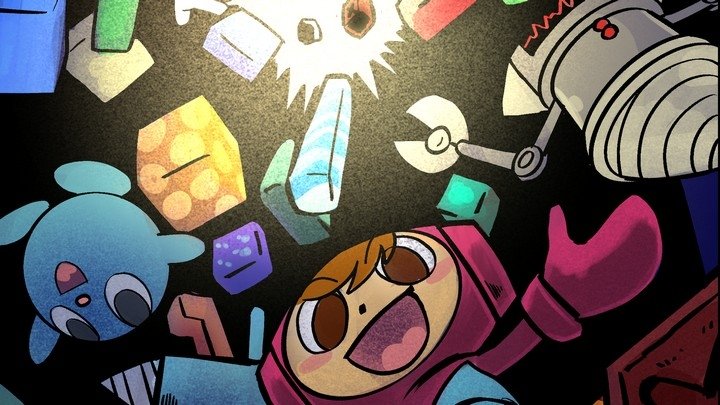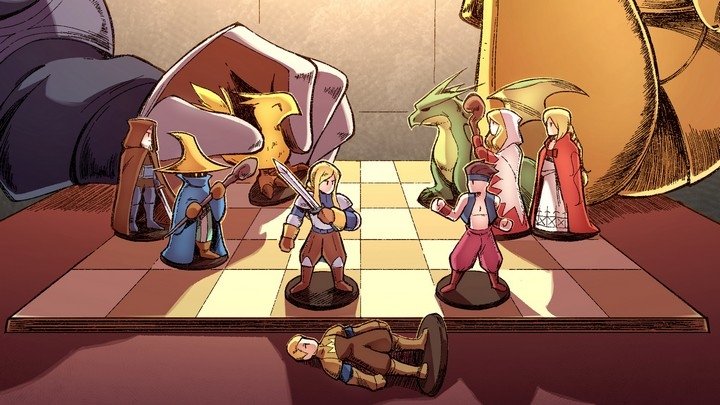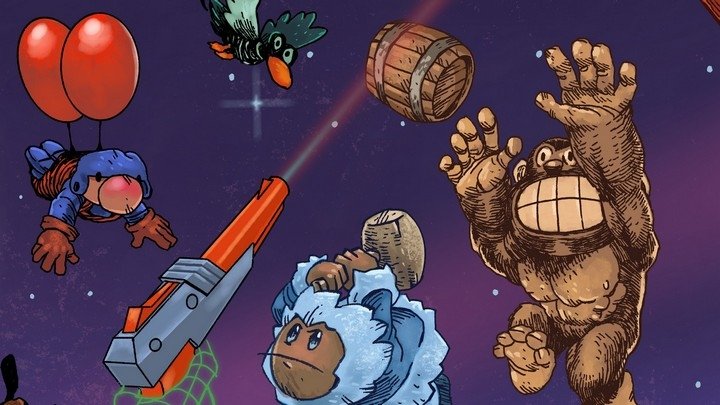On the occasion of Metal Gear's 30th anniversary...
A reprint of an old retrospective lost to the vagaries of time and the internet.
Konami's groundbreaking Metal Gear debuted 30 years ago this week on the MSX home computer: July 7, 1987. To mark the occasion, I'm republishing a retrospective I first published in 2008 but which has long been lost to the ether. Hey, Metal Gear games were all about recycling old material. It's totally fair. — Jeremy
I first discovered Metal Gear while reading a G.I. Joe comic book. I didn't have to play it or even read a gushing Nintendo Power sales pitch to be instantly smitten with the game; the ad alone did the trick. Metal Gear, after all, was published by Ultra Games (the tributary Konami had created in order to circumvent Nintendo's odd, fascistic refusal to let publisher release more than five titles per year, even if the sixth was indescribably awesome), and I suppose some of the parent company's advertising chutzpah rubbed off on its shell publishing front. Konami's ads were always enough to pique my interest back in the NES days. Something about them worked on a level few other companies could manage. Maybe it was all that silver-lined box art, which gave the company's creations a visual consistency that served as a more effective guarantee of quality than Nintendo's own name, which mostly belonged to the terribly dated black box series. Or maybe I was just young and malleable, exactly the sort of sucker they were aiming for.
In any case, Metal Gear's ad was something special: Almost a game in itself, packed with intriguing details that left a young nerd vividly imagining how those things could translate into a video game. Instead of focusing on vague claims of lifelike 3D graphics or other popular advertising lies which were obvious loads of horse-puckey even to a 13-year-old, Ultra's sales goons instead decided to focus on the substance of the game. "Gear Up!" the headline proclaimed, and then proceeded to demonstrate the multitude of gear with which its hero could go about gearing up, and the nature of each item's purpose. Action games didn't usually have much in the way of inventory back then; we were content with simple power-up paths of the weak-strong-stronger variety. But it was clear at a glance that Metal Gear's inventory system was considerably more substantial, something possibly even in Zelda's class. But this was no Hyrule fantasy -- it was modern army action. Just like a certain Modern Army Action Figure.

Metal Gear's NES-era localization is infamous for being, well, an NES-era localization. That is to say, obtuse and riddled with errors. Good thing those dark times are behind us. Right, Curly?
That alone was enough to secure my buying dollar. A glance at the game box inset below sealed the deal with its stylish black-and-white Ultra Games trade dress, a slightly-futuristic soldier (ripped straight from the year 2029, as it turned out) clinging stealthily to a wall, and what appeared to be a robotic battle tank. I was sold, instantly. And why wouldn't I be? It was the canniest marketing in the history of game marketing. I was helpless before Ultra's money-siphoning brilliance.
The game justified that unfounded love, despite a rocky start caused by sloppy porting. How was I, a young lad with no Internet and Nintendo Power as my sole source of gaming information, to know that my beloved NES Metal Gear was in fact a slipshod conversion of a considerably superior game for the MSX console/computer hybrid system? I didn't know most console games came from Japan back then, and I'd certainly never heard of an MSX. I just chalked up the poor grammar and confusing dialogue inconsistencies to the fact that video games were an inherently illiterate medium that would never be as intelligent as books or TV. And while I was baffled that I only ever took orders from Big Boss and the "Vernon KaTaffey" and "Commander South" referred to in the manual never appeared, it didn't seem too out of place. It's not like Mega Man ever mentioned "Monsteropolis" in-game, either. Despite some hiccups with missing text and the fact that I didn't quite "get" the concept of stealth, a grand time was had as I took down Outer Heaven again and again.
It says a lot for Metal Gear's innate quality that even an ineptly-produced butchery could stand alongside some of the best games for NES. Of course, had the game begun life on NES, it might have turned out rather less remarkably; much of the game's design was owed to the practical limitations of the MSX hardware, forcing to create a game about evasion and tool use. Thus hero Solid Snake quietly dodged video game action clichés and relied on stealth and his well-publicized gear to complete his mission, which was doled out in staccato bursts of radio transmissions and blurted revelations from grey-clad prisoners rescued along the way.

July 1989's G.I. Joe comix, both of which featured the ad sandwiched above on the inside front cover.
Metal Gear's spiritual similarity to G.I. Joe is clear as daylight at even a glance toward the triptych above: You have sneaky stealth on one cover, costumed heroes facing off against goofy themed villains on the other. The connection has only grown stronger as time as passed; Joe's star has waned for good, but Snake took up the mantle. One could argue that Metal Gear Solid filled the empty void in our Generation-X souls left by the fatal blow that the Clinton era inflicted upon the G.I. Joe franchise. It's not a tough argument. The bad guys in Metal Gear Solid 3 were called the freakin' Cobra Unit, for crying out loud.
But of course, the link didn't really strike me at the time; it only occurred to me after playing Metal Gear Solid. In hindsight, though, I can see that my love for the game comes from the same place as my affection for the toy and comic. That is to say, my vague fascination with military hardware and techniques, and my liberal-born need to see it all wreathed in a shroud of impossible fantasy rather than, you know, real war where people actually die for no good reason. Metal Gear satisfied both in spades; but even more than that, it offered the entire G.I. Joe experience all wrapped up in a single package, far more effectively than Taxan and Capcom's games based on the actual franchise did. Solid Snake was a code-named warrior sneaking into the fortress of a terrorist state, employing somewhat convincing high-tech military gear against both a legion of faceless footsoldiers and bosses with goofy names. Combined with the barebones text-based story, it offered young players both cartoon, comic book and action figure all in one. And as the ad promised, Snake came with lots of cool accessories to play with.
Of course, I'm really just talking about the comic here; while it's true that MGS was about a "FOOOX HOOOOUND!" battle cry away from being the Marvel Sunbow cartoon at times (especially when the villain managed to parachute out of a low-flying aircraft just in the nick of time), but on the whole the games are more in keeping with the tone of Larry Hama's comic. It's perhaps a curious coincidence that both series are the brainchildren of Japanese creators, although I wouldn't go looking for too much parallelism, there. Hama is a Japanese-American whose stint in Vietnam lent the intrinsic silliness of a comic book about toys an unexpected depth of realism; Kojima is Japan-born and -bred, and his own military experience consists of really liking Platoon. For more authenticity, he consults with Motosado Mori, a super-hardcore military otaku who would pretty much be running the Michigan militia if he lived in America. Hama, on the other hand, was forced to create serious plots about a guy dressed like a giant bird and a holographic ninja shape-changer. In other words, it all balances out.
I recently reread the two comics above to see if the parallelism was just me trying too hard to make a connection — both issues, released in July 1989, played host to Ultra's second run of Metal Gear print ads. (This was back in the day when publishers continued to promote and sell games after their first two weeks on shelves.) Perhaps it was simple serendipity, but Special Missions issue 23 and G.I. Joe issue 84 are pretty much Metal Gear in a nutshell — not just the NES game, either, but the entire series.
Metal Gear, G.I. Joe, and Important Life Lessons Therein

The first comic above, Special Missions 23, belongs to a series which was basically Hama using the popularity of the G.I. Joe brand to tell more hard-boiled army tales; most of his 28-issue run was divorced from the main comic's continuity, and often had nothing to do with the defense of human freedom against Cobra (that ruthless terrorist organization determined to rule the world). This particular chapter is about as hard-boiled as it gets, a self-contained covert op in which a small team infiltrates a Central American banana republic to rescue a U.S.-friendly (read: puppet) dictator from his counter-revolutionary captors.
The issue begins by showing some of the pre-mission preparation that would be too mundane for the continuity-driven fantasy drama of the main series: The team zeroing its weapons, adjusting its gear, performing test discharges, that sort of thing. Hama get to explain all of this to a reader cipher who takes the form of a documentarian named Scoop: A rookie fobbed off on the team by the heartless upper brass, who apparently don't care that sending along an untested soldier dressed in bright yellow is probably going to do terrible things to the integrity of the team's nighttime covert op. Damn the pencil-pushers, etc.! Like Metal Gear, Hama's Joe run was steeped in a sort of romantic cynicism about soldiers: They're thankless, unappreciated cannon-fodder who find no pleasure in doing what they have to do.
You don't have to look hard to find parallel themes in Metal Gear; Solid Snake and his super-soldier peers constantly disavow all knowledge of their awesomeness. It's one of those recurring motifs that appears in every chapter, like urinating soldiers and Otacon crying. At some point, some grizzled warrior's going to tell an awestruck neophyte that, nah, just 'cause they've saved the world a few times they're not that great. Modesty is the essence of soldiering.

Here, Tunnel Rat does his best to keep the new guy from bleeding out in a jungle by tweaking his equipment to be more combat-effective than its default form. Apparently something about contracting out to the lowest bidder negatively impacts quality, or something.
I'm sure he could have some awesome conversations with Big Boss about the best way to tweak gear. Maybe they'd find they had even more in common. Maybe love could bloom on the battlefield for them!

The whole point of Metal Gear is to avoid direct confrontation except when forced. Snake is no bulletproof death machine, at least not until he rescues enough hostages to bump up his rank and life bar. Generally speaking, any time you get into a firefight in the games, it's because you've screwed up. Your best tactic then is to turn tail and run until the heat dies down a bit.
And here we see a covert op has gone horribly wrong. In what must be a shocking inversion for anyone whose sole exposure to G.I. Joe was the cartoon, the bad guys — in this case Destro's Iron Grenadiers — are canny and tenacious. Once the ambush team's cover is blown, they're badly outnumbered and outgunned, and even though they'd entrenched themselves in an advantageous position. They'd been expecting amateur local forces rather than highly-trained elite mercenaries, and once everything goes pear-shaped the team leader calls for a retreat rather than make a stand and die pointlessly.
I'm pretty sure Sun Tzu once said that the trick to winning a war is to make sure you see the bad guys before they see you.

Ultimately, the Joe comic demonstrated a weary sense of pragmatism about warfare. The good guys believed in what they were fighting for, but good intentions alone aren't enough to win. When they lost, they licked their wounds and braced up for next time. 'Cause, hey, the good guys may not always win, but at least there'll be another try.
Of course, over in the main comic storyline, Hama matched the military realism with the ludicrous superhero drama aspect of the series. And that's what makes it so very Metal Gear. Or vice-versa.

While one Joe team was off skulking through Central American brush on a doomed mission, another group was running recon along the border of two small European nations seemingly set either side of the Warsaw Pact dividing line. Reasonable enough. But then Cobra had to get involved, testing a series of improbable stealth weapon modifications. Even that wouldn't be so bad but for the fact that this process consisted of an evil, bare-chested ex-dentist in a monocle spray-painting vehicles with silly-looking schemes designed to nullify radar systems, I assume, by making them vomit in confusion or disgust.
But it's OK, because the guy in the bright yellow uniform wearing a crappy Darth Vader mask broke the fourth wall a bit to make fun of the sheer preposterousness of it all. Just like when Snake interrupts someone to make fun of the impracticality of a walking nuclear missile launcher.

And, yeah, sometimes it's possible to take the above a little too far. This Camaro running joke, for instance. Or the entirety of Metal Gear Solid 2.

Yeah, in case you were wondering, something both series have in common is their sincere believe that ninjas are the answer to everything. No doubt ninjas could kick God's butt, if they weren't atheists. Here American ninja Snake-Eyes gives neon Darth Vader a good punch right in the respirator. You'd think this would hurt Snake-Eyes' meaty fist more than the target's metallic face, but you'd be wrong -- because he's a ninja.
Meanwhile, the only way Kojima could convince anyone to like whiny Raiden was to turn him into a ninja. But not just a ninja, no! A robot ninja. He may in fact be undead, too, which would make him a zombie as well. You know, for the full "pandering toward awesome via cliché" hat trick.
Yeah, so basically, the two franchises are pretty much one and the same. As you can see from this very scientific comparison and analysis.
There's one other similarity, too. Whenever they finally make that Metal Gear live-action movies, it's gonna suck just as hard as the G.I. Joe flick did.




